EXCEPTS FROM CHINESE DANCE
by Sun Jingchen, Luo Xiongyan, Zi Huayun
Heavenly Worlds
Jewels [on Earth]: Religious and Grotto Dances [DunHuang]
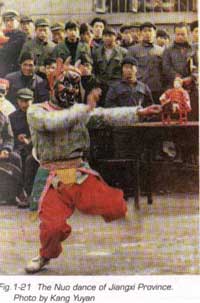 Another important component of the Chinese music and dance culture is the religious dance. The religious dance originated from the Wu (Sorcery Dance of the primitive society. Based on primitive beliefs, the Wu (sorcerer) had a close relation with dance from its birth. Shuowen jiezi, an etymological dictionary by Xu Shen of the Han Dynasty, said that the original shape of the character "Wu" (dance) was an imitation of a person dancing with two long sleeves. Thus the character means a person who could communicate between gods and men through dancing. That's why Wu (sorcerer) and Wu (dance) were always connected. With the maturing religious consciousness, Primitive sorcery gradually evolved into primitive religion with relatively fixed rituals, in which dance was an important element. This was a general phenomenon in the development of traditional religions in various Chinese ethnic groups.
Another important component of the Chinese music and dance culture is the religious dance. The religious dance originated from the Wu (Sorcery Dance of the primitive society. Based on primitive beliefs, the Wu (sorcerer) had a close relation with dance from its birth. Shuowen jiezi, an etymological dictionary by Xu Shen of the Han Dynasty, said that the original shape of the character "Wu" (dance) was an imitation of a person dancing with two long sleeves. Thus the character means a person who could communicate between gods and men through dancing. That's why Wu (sorcerer) and Wu (dance) were always connected. With the maturing religious consciousness, Primitive sorcery gradually evolved into primitive religion with relatively fixed rituals, in which dance was an important element. This was a general phenomenon in the development of traditional religions in various Chinese ethnic groups.
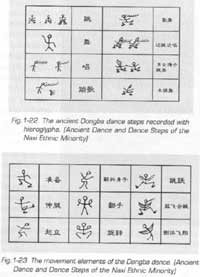 The soccer dance had a long history and profound influence. It had once reached a very high level. The Annals of jin recorded that in the Jin period, someone chanced upon the ritual of two witches (named Zhang Dan and Chen Zhu). The two were not only beautiful and well dressed their gait was also adroit and nimble. They were imitating the look and actions of some spirits with floating long sleeves with Superb skills. The last emperor of Chen in the Southern Dynasties had a favorite royal concubine named Zhang Lihua, who knew much about sorcery, and often gathered many witches in the palace to beat drums while singing and dancing. Although they did this with the excuse of paying tribute to gods, they were actually entertaining the emperor.
The soccer dance had a long history and profound influence. It had once reached a very high level. The Annals of jin recorded that in the Jin period, someone chanced upon the ritual of two witches (named Zhang Dan and Chen Zhu). The two were not only beautiful and well dressed their gait was also adroit and nimble. They were imitating the look and actions of some spirits with floating long sleeves with Superb skills. The last emperor of Chen in the Southern Dynasties had a favorite royal concubine named Zhang Lihua, who knew much about sorcery, and often gathered many witches in the palace to beat drums while singing and dancing. Although they did this with the excuse of paying tribute to gods, they were actually entertaining the emperor.
A great number of Wu dances are passed down today, and many of them can be traced to the traditional dances of various ethnic groups. (Fig.1-21) The Shaman dance of the northern ethnic groups, the Bon religious dance of Tibetans, the Nuo dance and Tiaoshen dance of the Han people, and the Shigong dance of the Zhuang ethnic minority, etc., all develop from sorcery dances. The Dongba dance of the Naxi people is very ancient and requires high skill. What's more interesting is that the Dongba scriptures have preserved dance steps with the ancient hieroglyph Dongba characters. (Fig.1-22) (Fig.1-23) 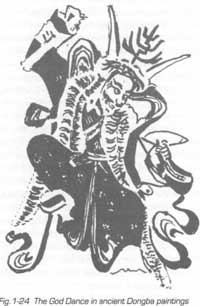 As the quality of these characters is close to photographs, the dancing characters are vivid as a direct painting of every dance. There are many categories in the Dongba dance. The "God Dance" describes the gods' adventures to establish their Sublime position; the "Instrument Dance" manifests the power of ritual instruments and weapons; the "Animal lmitation Dance" portrays various birds and animals; and the "Battle Dance" defeats demons to protect the religious power, etc. These are represe-ntative of the most common types of Wu dances. These dances still exist today, with old Dongba people still performing according to the ancient dance steps. The Dongba dance step is really a precious heritage in the history of the Chinese dance Culture. (Fig.1-24)
As the quality of these characters is close to photographs, the dancing characters are vivid as a direct painting of every dance. There are many categories in the Dongba dance. The "God Dance" describes the gods' adventures to establish their Sublime position; the "Instrument Dance" manifests the power of ritual instruments and weapons; the "Animal lmitation Dance" portrays various birds and animals; and the "Battle Dance" defeats demons to protect the religious power, etc. These are represe-ntative of the most common types of Wu dances. These dances still exist today, with old Dongba people still performing according to the ancient dance steps. The Dongba dance step is really a precious heritage in the history of the Chinese dance Culture. (Fig.1-24)
The religion of sorcery declined with the appearance of Taoism and the introduction of Buddhism. But after Taoism and Buddhism thrived, they also assimilated many local ancient dances into their religious activities. The newly-appeared Buddhist and Taoist dances also became important types of Chinese religious dance. Especially the Buddhist dances added greatly to the development of Chinese dance art. For instance, the temple fairs still popular today include activities like the Incense Fair, Travelling Fair and Flower Fair All these originated from the Buddhist ritual of "Xingxiang" (showing the Buddha). "Xingxiang" first appeared in India in the form of a mass activity to celebrate the birthday of Sakyamuni (the eighth day of the fourth lunar month). It was introduced to China with Buddhism. In the activity, the sculpture of the Buddha is placed on a splendid chariot. With drums, trumpets and other musical accompaniments, the chariot follows a fixed route and accepts the admiration, incense and flowers from the crowd. Following the chariot team are usually performers of music, dance and acrobatics. Fa Xian, an eminent monk of the Eastern jin Dynasty, recorded in his Travels Notes On TianZhu (India) that he witnessed two "Xingxiang" fairs on his journey to the West. One was in Yutian (present Hetian of the Xinjiang Uygur Autonomous Region); another was in the Middle Tianzhu (today's India). Fa Xian wrote, "On this day, all monks and laymen of the country gather to perform music and dance, present incense and flowers ... Buddhas then go into the city one after another and spend a night there. All lamps are lit through the night, with music and dance, and all other offerings to the Buddhas. Every country is just like this". This shows that most countries believing in Buddhism had this custom. By the time of the Southern and Northern Dynasties, this activity was already very popular in northern China. The Records of Qielan at Luoyang state that when the various temples held "XingXiang" fairs at Luoyang of the Northern Wei Dynasty, there were all sorts of acrobatics and performances, with music and dance all along the fixed route. At the front of the chariots team were auspicious lions to clear the road, and at the end were acrobatics and dancers who performed swallowing knives, spitting fire, climbing the flag polls, walking on tight ropes. "Strange skills and bizarre clothes are seen everywhere in the capital". This activity conglomerated all the local music and dancing artists who competed with each other every year The role of such activities on the development of music and dance is obvious. Many Chinese folk dances were preserved with Such religious activities.
Except for "XingXiang", the temples also gave music and dance performances in various rituals and fasts. The Annals of Sui: Music History states that Emperor LiangWudi of the Southern Dynasties was a faithful believer of Buddhism. After he was enthroned, he ordered new music pieces be created on Buddhism. He wrote the lyrics for three of the pieces- He also ordered the official Shen Yue to compose three pieces and gave them to the royal musicians to perform. Another 10 major pieces like "Shanzai", "Dayue", "Tiandao", "Mieguo'e", "Duankulun", etc., were also created to publicize Buddhism, and gained the title of "Zhengyue (orthodox music)". There were also "Fayue Tongzi ji" and "TongZi Yigefanbei" that were performed in every major Buddhist activity. It was with this championship of the rulers who believed in Buddhism that Buddhist music and dance thrived.
The Prince Hui of Qi in the Southern Dynasties composed the "Fayue Fanwu", In the jingle Temple, a famous temple in Luoyang, "upon the six fasts, there were always jiyue performers whose songs seemed to dangle among the roof beams. Their long sleeves turned slowly with the accompaniment of flutes and stringed instruments. All these were so enchanting," that the audience all thought they were brought into the nirvana (See the RecordS of Qielan at Luoyang).
The pure land of Buddha was actually a good place on earth. The music and dance performances were still popular in temples in the Tang Dynasty. At the capital Chang'an (now Xi'an), "most performances concentrated at the Ci'en Temple, the smaller ones were at the Qinglong Temple, and the others were at the jianfu and YongShou temples" (See e New Book in the South). The temple performances added a considerable impetus to the development of Chinese theatrical art. Another important note is that in the process of localization, Buddhism assimilated the traditional music and dances of many ethnic minorities of different regions for its own development needs. For instance, the Chamo performed in Tibetan temples, the Chagma popular in Mongolian temples, the peacock dance and big-drum dance of Dai temples and festivals, and the various dance shows in Han temple fairs, were all developed on the basis of traditional dances of different nationalities.
The contribution of Buddhist Culture that had the most profound influence on Chinese dance development was the numerous dancing figures in grottoes in regions reached by Buddhism. The grotto art also thrived with the introduction of Buddhism from India in the Southern and Northern Dynasties. It first appeared at the west end of the Silk Road, then from west to east, from the western regions to the central plains, the art left numerous grottoes. In the frescoes and sculptures in these grottoes, the dancing figures are omnipresent.
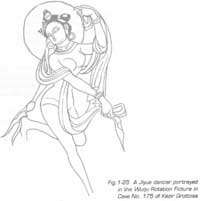 The earthly world can not live without music and dance, neither can the nirvana. Buddhist theories always say that in the nirvana, "holy music" never ceases for a moment. "All levels of the heaven present thousands of splendid flowers and dances to the Buddha and all Bodhisattvas", the scripture of Buddha expounded. Both Buddha and Bodhisattvas must have the offerings of fragrant flowers and dance. Hence dance scenes were always presented in the grotto frescos and sculptures trying to depict the nirvana of the Buddhist land. The images of flying asparas and "Jiyue" performers in the nirvana came from the music goddesses "jinnaluo" and "Gantapo" of the Buddhist legends. Except for them, the grotto art also records many perfor-mance scenes of music and dance, which were exactly the same with performances in this world.
The earthly world can not live without music and dance, neither can the nirvana. Buddhist theories always say that in the nirvana, "holy music" never ceases for a moment. "All levels of the heaven present thousands of splendid flowers and dances to the Buddha and all Bodhisattvas", the scripture of Buddha expounded. Both Buddha and Bodhisattvas must have the offerings of fragrant flowers and dance. Hence dance scenes were always presented in the grotto frescos and sculptures trying to depict the nirvana of the Buddhist land. The images of flying asparas and "Jiyue" performers in the nirvana came from the music goddesses "jinnaluo" and "Gantapo" of the Buddhist legends. Except for them, the grotto art also records many perfor-mance scenes of music and dance, which were exactly the same with performances in this world.
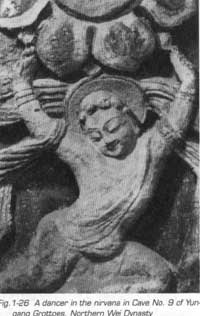 The dancing images in grottoes differ according to their regions and periods. This was due to the differences of artistic techniques and styles, the schools of Buddhism practiced in different regions, and what's most important, the traditional flavor and aesthetic habits of various local music and dances.
The dancing images in grottoes differ according to their regions and periods. This was due to the differences of artistic techniques and styles, the schools of Buddhism practiced in different regions, and what's most important, the traditional flavor and aesthetic habits of various local music and dances.
The Kezir Grottoes of the ancient Qiuci Grottoes in Xinjiang Uygur Autonomous Region are the biggest in scale and most intact in preservation. It is also among the earliest excavated Chinese grottoes. Scientific studies have determined that the construction of this grotto had started in the third century and ended in the ninth century, with a duration of 600 years. Among the abundant artistic relics are many jiyue Fig.s in the frescoes. These Fig.s provide the viewers a glimpse of the Qiuci music and dance that had once enchanted the entire county. The nimble gait and charming spirits could well be the best dance one can find. Some of the jiyue Fig.s depict the performers half or totally naked, which fully demonstrated the healthy beauty of human bodies. 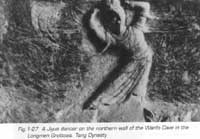 For instance, a jiyue performer in the Cave No. 175 has a gauze over the shoulders, her left hand rising and the right hand drooping. Her left foot tilts backward, and she stands on the right toe, with her eyes full of tender feelings and her body full of charms. From this we can clearly feel the influence of foreign culture. It also shows the aesthetic values of the time. This could be a symbol of the East and West Cultural exchanges on the Silk Road. (Fig.1-25)
For instance, a jiyue performer in the Cave No. 175 has a gauze over the shoulders, her left hand rising and the right hand drooping. Her left foot tilts backward, and she stands on the right toe, with her eyes full of tender feelings and her body full of charms. From this we can clearly feel the influence of foreign culture. It also shows the aesthetic values of the time. This could be a symbol of the East and West Cultural exchanges on the Silk Road. (Fig.1-25)
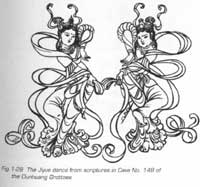 The Yungang Grottoes are another famous Chinese grotto group. The carving started in the Northern Wei Dynasty (about the fifth century AD) and declined at the end of the fifth century as the Northern Wei moved its capital. The images of Jiyue performers in heaven are very popular there. They are either playing instruments or dancing. Most of them are strong, carrying the beauty of strength and health. (Fig.1 -26)
The Yungang Grottoes are another famous Chinese grotto group. The carving started in the Northern Wei Dynasty (about the fifth century AD) and declined at the end of the fifth century as the Northern Wei moved its capital. The images of Jiyue performers in heaven are very popular there. They are either playing instruments or dancing. Most of them are strong, carrying the beauty of strength and health. (Fig.1 -26)
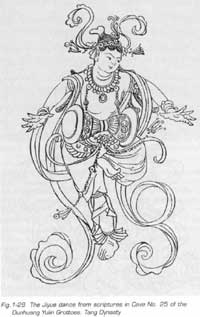 In the 17th year of the Taihe reign of the Northern Wei Dynasty (493), Emperor Xiaowendi moved the capital to Luoyang, where another major group of grottoes soon started. The Longmen Grottoes peaked in the Tang Dynasty and declined with its insurrection by An Lushan and Shi Siming. The dancing sculptures and images are also the best in the Tang Dynasty. The Wanfo (tens of Thousands of Buddhas) Cave that was started in the Tang Dynasty has a group of jiyue images: the musicians are playing instruments, the dancers are sitting or standing. A dancer on the northern wall raises both arms, her waist protrudes leftward. Her built is not big but she is elegant and charming, with the unique spirits of the Tang Dynasty jiyue dancers. (Fig.1 -27)
In the 17th year of the Taihe reign of the Northern Wei Dynasty (493), Emperor Xiaowendi moved the capital to Luoyang, where another major group of grottoes soon started. The Longmen Grottoes peaked in the Tang Dynasty and declined with its insurrection by An Lushan and Shi Siming. The dancing sculptures and images are also the best in the Tang Dynasty. The Wanfo (tens of Thousands of Buddhas) Cave that was started in the Tang Dynasty has a group of jiyue images: the musicians are playing instruments, the dancers are sitting or standing. A dancer on the northern wall raises both arms, her waist protrudes leftward. Her built is not big but she is elegant and charming, with the unique spirits of the Tang Dynasty jiyue dancers. (Fig.1 -27)
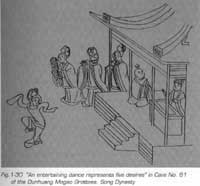 The Dunhuang Mogao Grottoes is surely a shining pearl on the Silk Road. It was first built in the Sixteen Kingdoms Period (the mid-fourth century) and lasted a very long time, with overhauling in the Qing Dynasty (1644-1911). Researchers have found over 2,400 colored sculptures and 45,000 square meters of frescoes. All of them converged the cream of the East and the West. It is no doubt an artistic treasure on the world level. The dancers' images are varied, ranging from the Northern Wei Dynasty to the Yuan Dynasty. From them we can catch a glimpse of the dances of various historical periods. It is a rare treasure of historical records. (Fig.1-28) (Fig.1-29) (Fig.1-30) (Fig.1-31 )
The Dunhuang Mogao Grottoes is surely a shining pearl on the Silk Road. It was first built in the Sixteen Kingdoms Period (the mid-fourth century) and lasted a very long time, with overhauling in the Qing Dynasty (1644-1911). Researchers have found over 2,400 colored sculptures and 45,000 square meters of frescoes. All of them converged the cream of the East and the West. It is no doubt an artistic treasure on the world level. The dancers' images are varied, ranging from the Northern Wei Dynasty to the Yuan Dynasty. From them we can catch a glimpse of the dances of various historical periods. It is a rare treasure of historical records. (Fig.1-28) (Fig.1-29) (Fig.1-30) (Fig.1-31 )
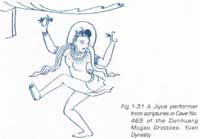 The dancing images in grottoes originated from the earthly world; it got distilled in the Buddhist pure land and then returned to this world. A layer of myth and imagination was added in this process, thus the dancing image was able to better express the Chinese nation's aspiration after the beauty of dance.
The dancing images in grottoes originated from the earthly world; it got distilled in the Buddhist pure land and then returned to this world. A layer of myth and imagination was added in this process, thus the dancing image was able to better express the Chinese nation's aspiration after the beauty of dance.
